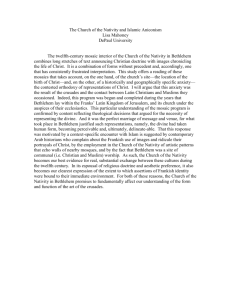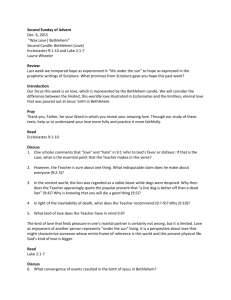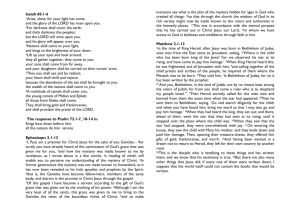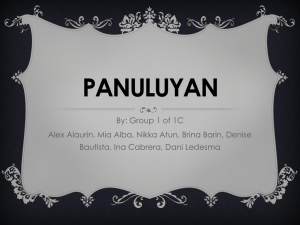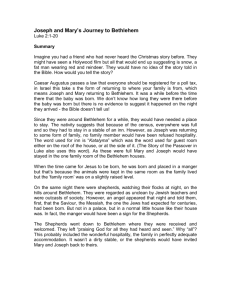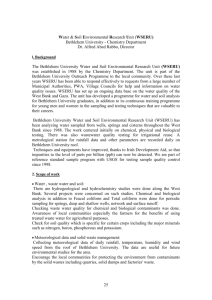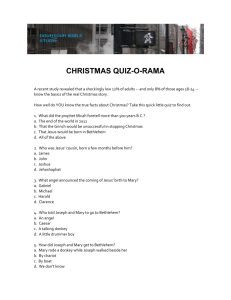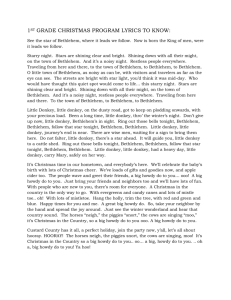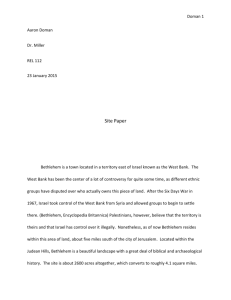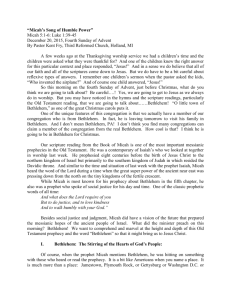The Poetry of the Nativity - Christ Church Cathedral Darwin
advertisement
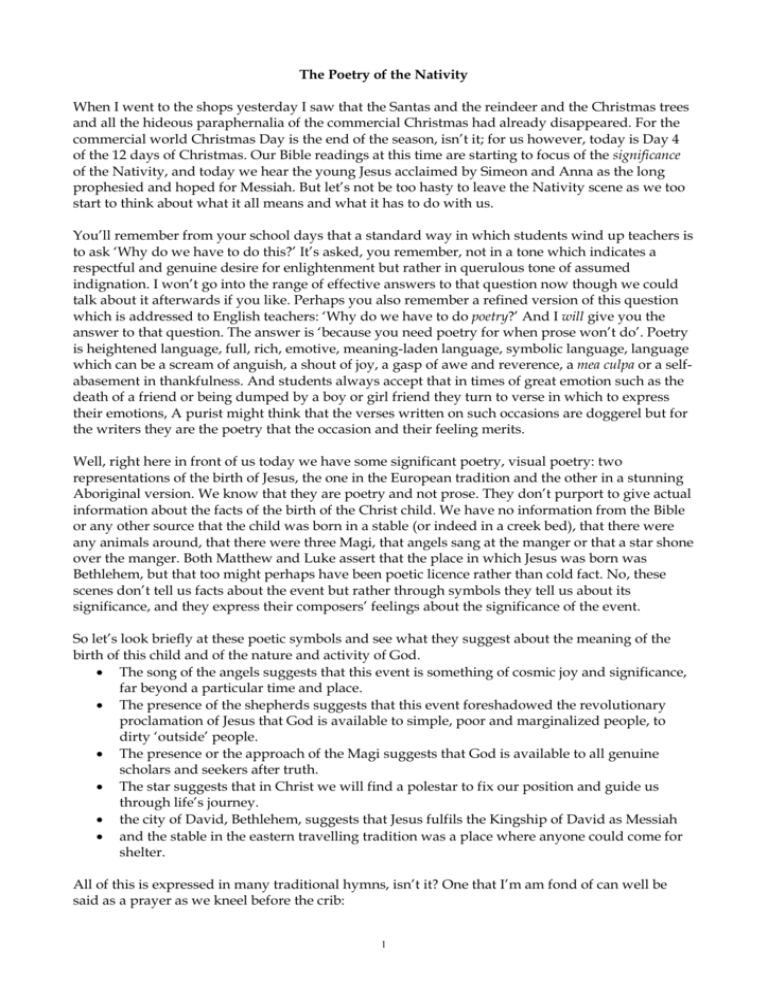
The Poetry of the Nativity When I went to the shops yesterday I saw that the Santas and the reindeer and the Christmas trees and all the hideous paraphernalia of the commercial Christmas had already disappeared. For the commercial world Christmas Day is the end of the season, isn’t it; for us however, today is Day 4 of the 12 days of Christmas. Our Bible readings at this time are starting to focus of the significance of the Nativity, and today we hear the young Jesus acclaimed by Simeon and Anna as the long prophesied and hoped for Messiah. But let’s not be too hasty to leave the Nativity scene as we too start to think about what it all means and what it has to do with us. You’ll remember from your school days that a standard way in which students wind up teachers is to ask ‘Why do we have to do this?’ It’s asked, you remember, not in a tone which indicates a respectful and genuine desire for enlightenment but rather in querulous tone of assumed indignation. I won’t go into the range of effective answers to that question now though we could talk about it afterwards if you like. Perhaps you also remember a refined version of this question which is addressed to English teachers: ‘Why do we have to do poetry?’ And I will give you the answer to that question. The answer is ‘because you need poetry for when prose won’t do’. Poetry is heightened language, full, rich, emotive, meaning-laden language, symbolic language, language which can be a scream of anguish, a shout of joy, a gasp of awe and reverence, a mea culpa or a selfabasement in thankfulness. And students always accept that in times of great emotion such as the death of a friend or being dumped by a boy or girl friend they turn to verse in which to express their emotions, A purist might think that the verses written on such occasions are doggerel but for the writers they are the poetry that the occasion and their feeling merits. Well, right here in front of us today we have some significant poetry, visual poetry: two representations of the birth of Jesus, the one in the European tradition and the other in a stunning Aboriginal version. We know that they are poetry and not prose. They don’t purport to give actual information about the facts of the birth of the Christ child. We have no information from the Bible or any other source that the child was born in a stable (or indeed in a creek bed), that there were any animals around, that there were three Magi, that angels sang at the manger or that a star shone over the manger. Both Matthew and Luke assert that the place in which Jesus was born was Bethlehem, but that too might perhaps have been poetic licence rather than cold fact. No, these scenes don’t tell us facts about the event but rather through symbols they tell us about its significance, and they express their composers’ feelings about the significance of the event. So let’s look briefly at these poetic symbols and see what they suggest about the meaning of the birth of this child and of the nature and activity of God. The song of the angels suggests that this event is something of cosmic joy and significance, far beyond a particular time and place. The presence of the shepherds suggests that this event foreshadowed the revolutionary proclamation of Jesus that God is available to simple, poor and marginalized people, to dirty ‘outside’ people. The presence or the approach of the Magi suggests that God is available to all genuine scholars and seekers after truth. The star suggests that in Christ we will find a polestar to fix our position and guide us through life’s journey. the city of David, Bethlehem, suggests that Jesus fulfils the Kingship of David as Messiah and the stable in the eastern travelling tradition was a place where anyone could come for shelter. All of this is expressed in many traditional hymns, isn’t it? One that I’m am fond of can well be said as a prayer as we kneel before the crib: 1 1. O little town of Bethlehem, how still we see you lie! Above your deep and dreamless sleep the silent stars go by: yet, in your dark streets shining the everlasting light, the hopes and fears of all the years are met in you tonight. 2. For Christ is born of Mary; and, gathered all above, while mortals sleep the angels keep their watch of wondering love. O morning stars, together proclaim the holy birth, and praises sing to God the King and peace to all on earth. 3. How silently, how silently the wondrous gift is given! So God imparts to human hearts the blessings of his heaven. No ear may hear his coming; but in this word of sin, where meek souls will receive him, still the dear Christ enters in. 4. O holy child of Bethlehem. descend to us, we pray; cast out our sin and enter in, be born in us today. We hear the Christmas angels their great glad tidings tell: O come to us, abide with us our Lord Immanuel. The Bethlehem which carries so much symbolic meaning for Christians is the Bethlehem of the heart. Yet of course Bethlehem the town exists today. While it has known much violence and strife throughout its history, including its very recent history today it is at peace, yet as I heard its mayor say on TV it is ‘an empty shell’ because visitors come only by bus from Jerusalem, visit the church briefly and are hurried back to the big city. The city has lost 14% of its area as a 9.3 metre wall has been built on three sides of the city, which apart from anything else cuts off the city’s view of the beautiful hills of Judea; and the fourth side consists of a checkpoint. But the contrast between the deep and dreamless sleep of the Bethlehem of the hymn and the anxiety and poverty of the Bethlehem of today can be a creative and prophetic one of us. The poetic and prophetic Christmas message of hope is the assurance that in the birth of Jesus the light shined in the darkness and the darkness was not able to overcome it; it is shining in the darkness of our world and the world has not overcome it; and it will shine in the darkness of the future and that darkness too will not overcome it. The contrast between the Bethlehem of the hymn and the Bethlehem of today tells us that we have work to do. We know that in an imperfect world we are to be the bearers of that light. We might also reflect that to be the body of Christ child who grew to be the redeemer of the world means that we also have to take on our share of the burden of suffering that such redemption entails. But that’s a reflection for another time. For today, as we come again before the Christ child in this Christmas season let us too pray O holy child of Bethlehem. descend to us, we pray; cast out our sin and enter in, be born in us today. We hear the Christmas angels their great glad tidings tell: O come to us, abide with us our Lord Immanuel. 2
